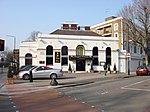Ben Uri Gallery & Museum
1915 establishments in EnglandArt museums and galleries in LondonArt museums established in 1915Jewish museums in the United KingdomMuseums in the City of Westminster ... and 1 more
Use British English from August 2015

The Ben Uri Gallery & Museum is a registered museum and charity based at 108a Boundary Road, off Abbey Road in St John's Wood, London, England. It features the work and lives of émigré artists in London, and describes itself as "The Art Museum for Everyone". Its website includes the museum's collection, reflecting the Jewish and immigrant contribution to British art since 1900, including an itemised exhibition list from 1925 onwards, a digitised archive and catalogue of its art reference library. It also includes online exhibitions, podcasts and audio material.
Excerpt from the Wikipedia article Ben Uri Gallery & Museum (License: CC BY-SA 3.0, Authors, Images).Ben Uri Gallery & Museum
Boundary Road, London South Hampstead (London Borough of Camden)
Geographical coordinates (GPS) Address Website Nearby Places Show on map
Geographical coordinates (GPS)
| Latitude | Longitude |
|---|---|
| N 51.5375 ° | E -0.1854 ° |
Address
Village Vet
Boundary Road 110
NW8 0RH London, South Hampstead (London Borough of Camden)
England, United Kingdom
Open on Google Maps










